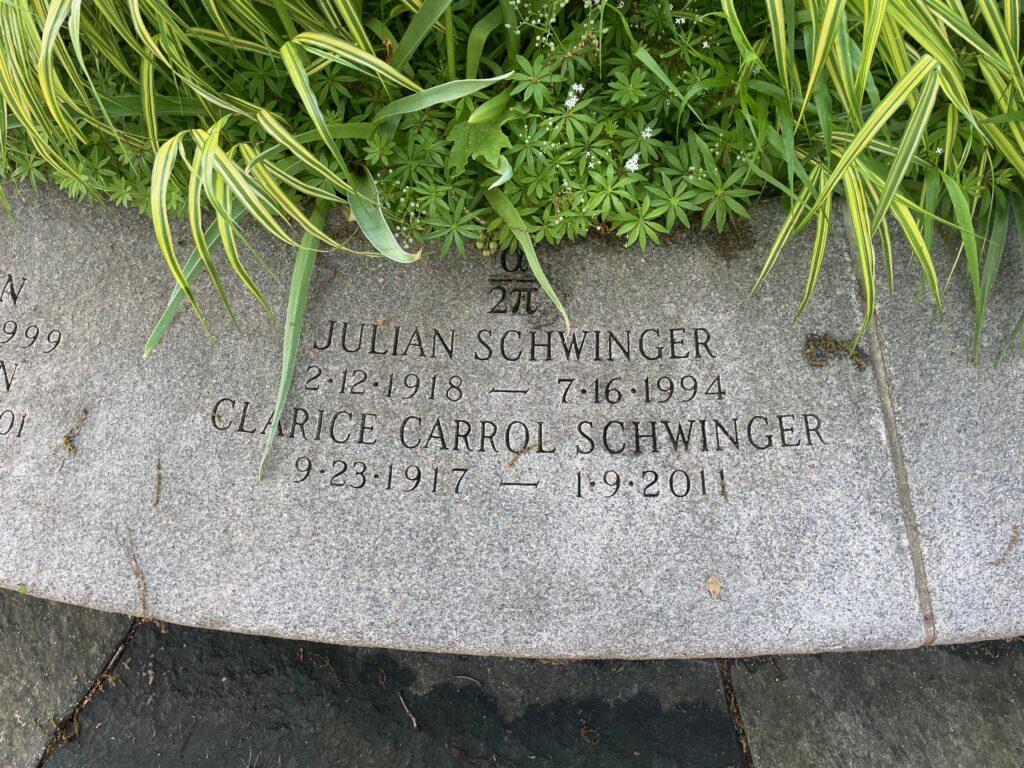Erik Visits an American Grave, Part 1,939
This is the grave of Julian Schwinger.

Born in 1918 in New York City, Schwinger grew up in a Jewish immigrant household. His father was a scumbag sweatshop operator, exploiting his fellow Jews such as the men who caused the Triangle Fire. Well, that’s how one made money I suppose. I wonder what would have happened to the children of the sweatshop workers if they had a fair shake. But America was never anything remotely approaching a meritocracy, despite its myths that still exist today. Anyway, Julian Schwinger was a super talented kid who got a great education. He got into Townsend Harris High, a school for gifted children. He was super into physics and was already reading scientific papers by the time he was in high school.
The family’s fortunes declined with the Great Depression and so Schwinger ended up at City College, both because it accepted all Townsend Harris graduates and because it offered free tuition. He was a mixed student. As with a lot of scientists, he was totally indifferent to the humanities and blew off those classes, focusing on his math and science. His grades reflected this. But his science mentors recognized his tremendous talent and using many connections, got him transferred to Columbia despite his poor overall grades. Unsurprisingly, he did great there and not only did he finish, but he immediately went onto his PhD and got that at the remarkable age of 21.
Schwinger began working at the University of California under the mentorship of J. Robert Oppenheimer. He got a tenure-track job at Purdue University but did not teach there much. During World War II, he worked at the MIT Radiation Laboratory, doing his part on the Manhattan Project, though not at Los Alamos. He immediately left Purdue in 1945 and headed to Harvard, where he would be for the next 30 years.
As is well established now by the unusual number of physicists cover in recent months in this series, I do not have a very good grasp of the basics of this incredibly complex field. So bear with me and just talk about it in comments when I screw it up. Ah hell, let’s just quote the Nobel Prize site, which he won in 1965:
In subsequent years, he worked in a number of directions, but there was a pattern of concentration on general theoretical questions rather than specific problems of immediate experimental concern, which were nearer to the center ot hls earlier work. A speculative approach to physics has its dangers, but it can have its rewards. Schwinger was particularly pleased by an anticipation, early in 1957, of the existence of two different neutrinos associated, respectively, with the electron and the muon. This has been confirmed experimentally only rather recently. A related and somewhat earlier speculation, that all weak interactions are transmitted by heavy, charged, unit-spin particles still awaits a decisive experimental test. Schwinger’s policy of finding theoretical virtues in experimentally unknown particles has culminated recently in a revived concern with magnetically charged particles, which may also be involved in the understanding of strong interactions.
In later years, Schwinger has followed his own advice about the practical importance of a phenomenological theory of particles. He has invented and systematically developed source theory, which deals uniformly with strongly interacting particles, photons, and gravitons, thus providing a general approach to all physical phenomena. This work has been described in two volumes published under the title “Particles, Sources, and Fields“.
Awards and other honors include the first Einstein Prize (1951), the U.S. National Medal of Science (1964), honorary D.Sc. degrees from Purdue University (1961) and Harvard University (1962), and the Nature of Light Award of the U.S. National Academy of Sciences (1949). Prof. Schwinger is a member of the latter body, and a sponsor of the Bulletin of the Atomic Scientists.
No shame in outsourcing to people who know what they are talking about!
In the 70s, Schwinger left Harvard for UCLA. The main reason is that he was such an egocentric jerk that his colleagues loathed him. He also thought he was better than all of them and told them that. It’s true that his research agenda was quite a bit different and sometimes at these big schools with big egos that can be a major issue, but here I think it was compounded by Schwinger’s ego.
Anyway, Schwinger died in 1994, while still based in LA. He was 76 years old.
Julian Schwinger is buried in Mount Auburn Cemetery, Cambridge, Massachusetts. Maybe he was going to leave Harvard, but not for his death.
If you would like this series to visit other Nobel Prize winning physicists, and boy do I like talking about physics!, you can donate to cover the required expenses here. Maria Goeppert Mayer is in San Diego and Murray Gell-Mann is in Aspen, Colorado. Previous posts in this series are archived here and here.


